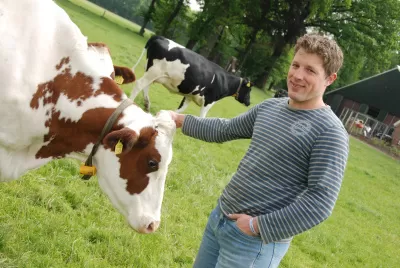The soil environment determines how a crop 'feels’
A Kinsey-Albrecht analysis is the construction drawing of the soil
Marco van Gurp, soil and fertilising specialist of N-xt Soil Services, likes to compare cows and crops. With that comparison he has managed to open the eyes of many a dairy farmer and inspired them to obtain more knowledge of their soil and fertilisation. “A higher business yield often starts with improving soil quality”, comments Marco Van Gurp, who comes across increasing numbers of dairy farmers who like to start on improving their soil quality.
The cow and the crop
The environment of the cow determines how the cow feels and this includes a number of important factors. For example a cow can survive for three weeks without food, three days without water and just three minutes without air. In other words, water and air are essential to a cow. Reason for many dairy farmers to remove the side walls from their sheds and to pay more attention to the quality of drinking water. You can simply translate this to the soil and the crop. The environment determines how a plant feels. Again water and oxygen are the primary life needs. The same applies to the plant and to the soil life around it. In order to achieve the correct water:oxygen ratio (25%:25%) in the soil, you need an optimum soil structure. Such a structure can only be achieved if you have the correct calcium/magnesium ratio in the soil.
Construction drawing of the soil
The Kinsey-Albrecht soil analysis is essentially the construction drawing of the soil. It shows the ratios between the most important cations (positively charged minerals) in relation to the clay-humus complex (CEC), which produces the total exchange capacity (TEC).
What I'm trying to say is that if you only think about feeding the cow or the plant in the best possible way, you are missing some crucial points. The environment has to be perfect too. More to the point, only if the environment is completely perfect, will the plant be vital and grow most efficiently!
What I'm trying to say is that if you only think about feeding the cow or the plant in the best possible way, you are missing some crucial points. The environment has to be perfect too. More to the point, only if the environment is completely perfect, will the plant be vital and grow most efficiently!
To lime or not to lime
Where traditional soil analyses opt for the 'plant-led approach', the Kinsey-Albrecht analysis goes for a 'soil-led approach’. A practical example at the farm of the Bolscher family explains the difference. The pH is good, so traditional wisdom has it that liming is not necessary. However, according to Kinsey-Albrecht the pH is the result of the percentages of cations on the CEC. You could have a different pH, even though the mineral ratios in the soil are perfectly okay. On the other hand you could measure the correct pH, even though the mineral ratios in the soil are not at all in order. The following analysis shows it clearly.

With a TEC of 11 (10.89) you have an optimum ratio of Ca and Mg of 68:12. In this soil we measure a ratio of 56:23. In short, the Ca is too low and the Mg is too high!
Yet these ratios determine the structure and the water:oxygen ratio in the soil. If we only use the pH as a measure we do nothing, even though soil could be optimised by liming. The type of lime and the amount of lime that is administered are of the utmost importance of course! (If you would like more details, please contact N-xt Soil Services).
On the basis of this analysis, dairy farmer Koen Bolscher is one of the few dairy farmers in his area who limes. With excellent results to date!


